Ah, kua tae mai te rā whakatā. The weekend has arrived!
Cover image via Ensemble Magazine.
The week in Greater Auckland
In Monday’s post, Heidi explained that for the Government’s strategic direction, the road authorities need to read the GPS – they shouldn’t just blindly keep spending Activity Class funds in the same old way.
On Tuesday, Matt wrote about the Notified Unitary Plan, which is currently being consulted on.
Wednesday’s post was a guest post by David Slack, about the exciting surge of high-speed rail projects in Europe.
Yesterday, we shared a guest post by Grady Connell about the importance of the local dairy.
Park up this Friday
World Park(ing) day events are planned across the 16-18 of September, and Aotearoa’s official Park(ing) Day is this Friday, the 16th, nicely timed for Architecture Week, so keep your eyes peeled for creative re-imaginings of what parking spaces could become if they weren’t storing someone’s car. You can even set up your own Park(ing) Day installation yourself: our friends at Bike Auckland have more details.
For those who want to get involved, the Parking Day founders have created an easy step-by-step guide for converting car parks. It is best to choose a metered parking space, and to pay for it for as long as you are there. You should make defined boundaries around your parking space, to keep everyone safe. Be prepared to kōrero as well, as users of your installation, passers-by or drivers looking for a park will likely chat with you.
She’s through!
Dame Whina Cooper broke through at Te Waihorotiu Station: the tunnel boring stage of CRL construction is now complete.
Enjoying a car-free moment in Ellerslie
The Ellerslie Fairy Festival and Pirate Party (that sounds like a good time) brought the crowds to the main street last weekend. From this angle, the festival looks like fun for the community and great for businesses. How about a summer of local street parties?
https://twitter.com/nzroo/status/1568741854547701760?s=46&t=ydmrqcx5ubE2N4jSI50NeQ
Mayoral candidates on light rail
Dileepa Fonseka asked this week why none of Tāmaki Makaurau’s mayoral candidates want to talk about light rail. Of the three highest-polling candidates, Efeso Collins, Viv Beck and Wayne Brown, only Collins is in favour of light rail at all, and even then he’d prefer a cheaper surface option:
Coalition for More Homes spokesperson Scott Caldwell says examples of light rail cars running through tunnels overseas are generally pre-metro systems where people have decided to create the tunnel with an eye to later running a metro system right through it.
The reason they build a metro or surface light rail (or both separately) is because tunnelled light rail means you don’t get the metro’s advantages of automation and speed, or the accessibility advantages you get with surface light rail.
Matt Lowrie, editor of Greater Auckland, a public transport advocacy blog, says the tunnelled light rail option is effectively the worst of both worlds.
He also argues it doesn’t represent great value, because for $2b more you could experience the full advantages of a light metro system and for $7b less you could have a surface light rail system which would be accessible to more people. Or, you could spend that $15b on something else entirely.
Friend of Greater Auckland and regular guest poster Tim Adriaansen is also quoted, touching on the risks of such a large project to our construction sector.
Within the infrastructure industry, he says there is little confidence that this project will actually be delivered. “A lot of people are hesitant to support the project with too much capacity within their organisations because they’re not confident that this will ever actually go ahead.”
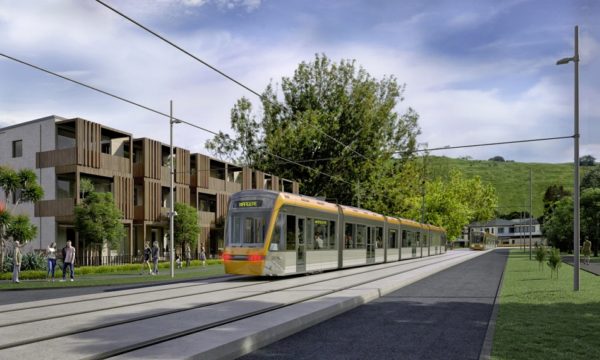
Posters on Election Issues
Are you wondering what you can do to raise climate transport policy issues in this local election? Here’s one idea: put some posters up to remind voters to discuss the issues with candidates. Suraya Sidhu Singh has created some gorgeous linoprint posters:
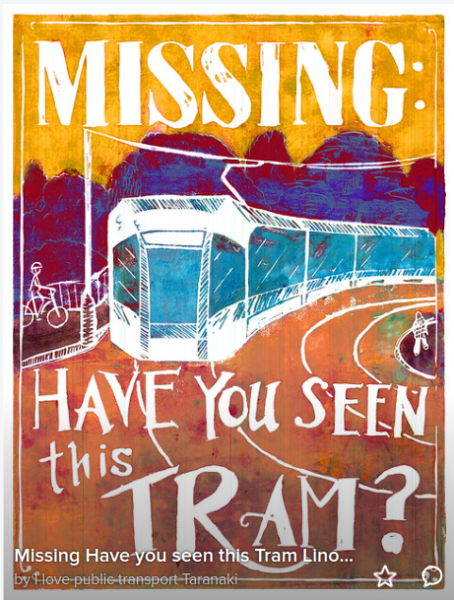
Suraya has released the images under Creative Commons and says anyone is welcome to use them for any non-commercial purpose that promotes public transport. Here are some examples where they’re out in the wild:

Petrol prices lead to a fall in consumption
Since Russia invaded Ukraine at the start of this year, petrol prices have soared and we’ve bought less of it in response. Other factors, such as ongoing COVID-19 infection rates and more people working from home, have influenced the drop in petrol consumption. But despite those factors, its very likely Peak Oil for Aotearoa was in 2019.
Massey University’s Robert McLachlan points out that while everywhere on the planet is experiencing an oil price crunch, the message we’re getting here isn’t quite the same:
European consumers have experienced a more expensive energy crunch, McLachlan said. At the same time, global climate campaigners have also encouraged citizens to see ditching fossil fuels as a civic duty. But that message has been largely absent from New Zealand, he added.
“I don’t think there is much conscious use to conserve oil for environmental or geopolitical reasons, especially as we are not getting those signals from government.”
Addressing the park’n’ride problem
This week, Todd Niall looks into park and ride facilities, and the missing links in our public transport network. Why do so many people drive to their nearest rapid bus station or ferry terminal, rather than taking a connecting bus, walking, or cycling? People interviewed in Niall’s piece had a range of answers, from the lack of good local PT connection, the distance being a bit far to walk to the overwhelming convenience of driving. Park and ride facilities with masses of free parking create a huge incentive to make that local trip by car.
Getting on with bikes in Ōtautahi
Stuff is publishing an excellent series of articles this month about cycling in Christchurch, so we thought we’d share a few here. Sarah Bennett has an overview of the city’s most beautiful bike journeys, from the coastal ride to Sumner to mountain biking in the Port Hills, to a 50km ride out to Banks Peninsula. Sounds like a dream of a summer holiday to us.
Glen Koorey writes a cyclist’s-eye-view opinion piece, mythbusting some common claims made about biking in Christchurch.
Myth 3: it’s too cold and wet
Many people claim that it’s too cold or wet in Christchurch to cycle (somehow this doesn’t seem to stop many people biking in Amsterdam or Copenhagen). In reality, Christchurch has one of the best climates for cycling in the world, rarely going below 0 degrees Celsius or above 30C and with only about 4% of hours ever having more than light drizzle.
And Will Harvie speaks to several Ōtautahi councillors, each in favour of bike lanes, but with different views on how bike lanes should be built, and how much they should cost.
[Councillor Aaron Keown] is adamant that Christchurch’s cycleways have “too much hard engineering”. “All of our cycleways should have been done in a more temporary way, to make sure they’re working”. The city should use road paint, plastic bollards, moveable planter boxes and so forth to segregate bikes from cars, said Keown.
If some cycleways were to attract decent numbers, the council could assess whether “we need to pour a few tons of concrete and stuff to make [them] better”, said Keown.
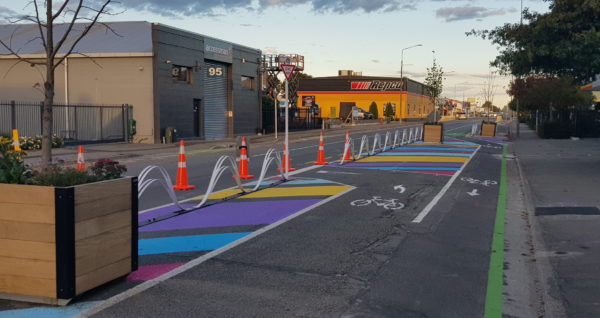
A low-traffic foreshore for Picton
Waterfront transformation can make a difference to small towns, too. We love the language used to describe a new plan for Picton’s waterfront street, which will ‘de-emphasise’ the ‘dominance’ of the road, using a number of landscape interventions to make the space safer and more welcoming for people.

A year of The Week in Flooding
We’ve been including a section called ‘The Week in Flooding’ in Weekly Roundup for a year now. The Week in Flooding was a spontaneous addition to that September 2021 post, and we didn’t plan for it to be a regular feature. But there’s been flood (or other extreme weather) related news nearly every week since, and The Week in Flooding looks like it will stick around.
While some weeks it feels like a bleak corner of Weekly Roundup, we’ve come to value it as a space to put transport emissions in the context of the wider climate crisis.
This week, we want to talk about China’s heatwave.
China has suffered through its hottest summer ever this year, and the New York Times has an essay about one family’s experience getting through the heat.
Subway stations were blacked out. At night, buildings were darkened and streetlights were dimmed. We fled the deserted streets one day for refuge in a mall, hoping to cool down, but restrictions on electricity had left it as hot and humid as the outdoors.
A city of more than 20 million people had become practically unlivable.
While in Chile, high temperatures are melting glaciers.
Record temperatures causing glacier collapse this week in Chile, as captured on social media and making the rounds. If anyone knows who to credit for this, tell me.
More here from Reuters: https://t.co/92aDJ8Mhze pic.twitter.com/iEbXlmLnlP
— Paul Kedrosky (@pkedrosky) September 13, 2022
A minute’s worth of pollution
A smart way of illustrating the pollution produced by an idling car.
https://twitter.com/_dmoser/status/1567052846801059840?s=46&t=FXweWIQYTi8GXam7glixMw
Getting to school on your own two wheels
A lovely visual essay on Stuff explores the school run – and why so many fewer kids use a bike to get there than they once did. Follow the link for the beautiful graphics, stay for Joke Corner – and check out the data analysis Stuff did, which included a useful tool:
Finally, for each neighbourhood, we also calculated the straight-line distance to the nearest school (normally a primary or intermediate school). The radar charts below show how all of these factors – terrain, distance, and wealth – interplay to affect cycling rates.
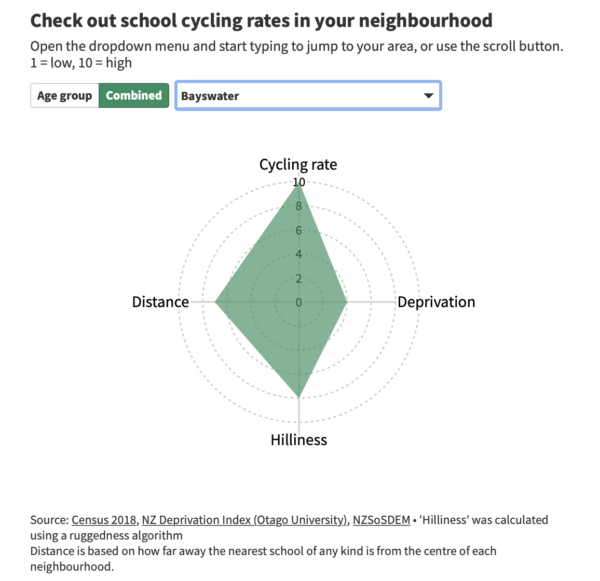
Distance is based on how far away the nearest school of any kind is from the centre of each neighbourhood. A Flourish data visualisation.
Taking cars out of school streets
The school-run traffic chaos is a problem on streets outside schools worldwide, and here’s the story of a school in the UK that’s banning (most) cars in an effort to make the journey safer for their students.
The scheme works by limiting vehicle access at the start and end of the school day to open up the streets outside schools for walking, cycling and scooting. So rather than 100+ vehicles converging on a small stretch of road for a short period, only local residents, those with disabilities and those with special needs can drive down the road at this time. The result has been a significant shift in the way pupils arrive at school.
Vertical learning in Brisbane
And while we’re on the subject of schools, how beautiful is this multi-storey urban high school in Brisbane?
Instead of the more typical school setting of horizontal circulation between dispersed low-rise classroom blocks, in Barrambin teachers and students are bonded in their use of the same grand stair throughout the day, their physical energy becoming social in these vertical transitions
Time for Auckland City Centre’s first vertical school? With safe and playful quiet streets around it, of course!

Making cities that work for tamariki
We may have featured the charming Japanese show First Errand on Weekly Roundup before. In the show, camera crews follow Japanese pre-schoolers as they undertake astonishingly long and complex errands, all by themselves. It’s on Netflix, if you’re curious.
Episode 505 of the excellent podcast 99% Invisible explores why such a show is possible in Japan and why, in fact, Japanese cities are so safe that 10 year olds can make 85% of their weekday trips on their own.
But it’s not just the distance between home and school that determines whether kids can safely make the walk. There’s also another urban design factor: the size of the streets. In Japan, residential streets are much narrower. In part, unlike in the US, horse-drawn carriages never became common on Japanese streets in the era before the automobile. And without carriage traffic, streets just didn’t need to be that wide.
Who has the right to feel invincible?
https://twitter.com/carlafrancome/status/1569068237413044224?s=46&t=7iwnVDByIuhS1_kxermJKQ
Thinking of getting an EV? Try an ebike
Aimed squarely at a 4WD, aspirationally outdoorsy audience, Outside Magazine has a pretty convincing missive in favour of the ebike (we didn’t need convincing, but we enjoyed it anyway), listing all the ways in which an ebike is a far better option than a Cybertruck.
With our actual, daily use in mind rather than our imagined #livingmybestlife version, comparing four wheels (ICE or EV) to two, an e-bike comes out clearly on top on almost every measure. And people are noticing. The last two years, e-bikes have outsold EVs in the U.S. Recent research shows there’s significant public interest in mode-switching to bikes if cities have safe infrastructure; some 70 percent of people in the 50 largest metro regions in the U.S. say they would like to ride more, but don’t because of concerns about safety in traffic.
And why not? Ebikes are, after all, the summer accessory to beat
Speaking of aspirational, local cool fashion magazine Ensemble’s latest editorial spread was all about ebikes.
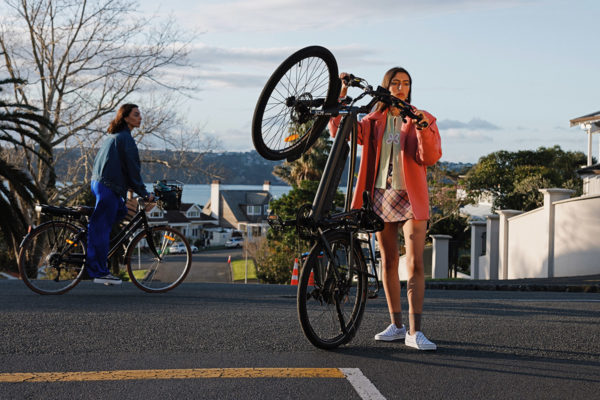
POV: doing urbanism right
(Point Of View from some app called TikTok, where, it seems, all the young people hang out these days)
Gen Z get it pic.twitter.com/IU1hGgHuId
— David Milner (@djjmilner) September 13, 2022
I ngā wā o mua, ko te reo māori te reo kaipakihi
Once upon a time, not that long ago, good grasp of Te Reo Māori was necessary if a person wanted to get by in business in Aotearoa.
https://twitter.com/chamfy/status/1568820930046230531?s=46&t=7qCoCRR2z0AqMgOQeFBfcQ
Ka kite! Hope you’ve got a great weekend ahead of you.

 Processing...
Processing...
Only 2.5 more years (at least) until the CRL is open…..
:'(
https://www.treehugger.com/architect-guide-19-ways-to-build-better-housing-6654200
That was very interesting, thanks for sharing.
Interestingly the first half a dozen items is essentially just the NPS-UD
The Herald has run a series on Mayoral candidates this week:
https://www.nzherald.co.nz/nz/auckland-mayoralty-wayne-brown-on-slashing-council-salaries-and-speeding-up-bus-journeys/BG6HJCSKYHGASXA2XYKJWJHY44/
https://www.nzherald.co.nz/nz/auckland-mayoralty-efeso-collins-plans-to-ditch-his-car-one-day-a-week-he-wants-others-to-do-the-same/UFL5NVTK3F7ICKVIFOXZWQA6YQ/
Would have been good to also mention that Reshaping Streets consultation closes on Monday
https://www.nzta.govt.nz/about-us/consultations/reshaping-streets-consultation/
+ This will allow for pilots to be used as consultation
+ It will allow for roads to be closed off by modal filters to make low traffic neighbourhoods
+ It supports Play Streets and school streets
+ It creates a new decision making process for traffic controls
Most of it is pretty good – but it could be better with setting out clear powers for all RCAs – public and private to make decisions about traffic controls.
The Rule needs to give RCAs powers to define what vehicles can go on what streets – to really control the roads. Creating bus gates and other controls let control happen by signs and fines not just physical barriers.
Lots of good stuff to support
So for that World Parking Day, is there not any legal rules about sitting in a parking spot? Hard to believe you can just camp out in one without a vehicle?
Great work Suraya!
I made this up about the final CRL breakthrough which also includes Newshub’s item at the end plus some stills ;-
And Auckland’s 2nd TBM the Central Interceptor is now starting it’s way under the Manukau Harbour ;-
https://www.1news.co.nz/2022/09/15/first-tunnelling-to-begin-under-major-new-zealand-harbour/
Great podcast out today as well from Bernard Hickey.
Well worth a listen, and exciting to hear mention that Waka Kotahi are looking at optimising road maintenance programmes sounds like what Jolisa suggested (https://www.greaterauckland.org.nz/2021/03/10/gold-in-them-there-road-renewals/)
“So who ‘owns’ the car parks?”
https://thespinoff.co.nz/podcasts/when-the-facts-change
Petrol prices have not really seen a drop in demand. Recession fears and WFH have had an effect on US gasoline prices and as we move toward the NH winter, global gasoline (petrol) prices will tumble further.
At the same time, diesel and aviation fuel prices are going to roof. This is because the huge amount of flow from Russia to Europe is going to be diverted to South America and Africa after January and the cost of replacing that fuel will be huge.
With Natgas also tuned off from Russia, electricity prices will be really high as well.
The net result of all this will be that governments will start to subsidise fuels and European demand for Petrol will remain or even increase.
This from a Reddit Posting with AT finally telling the TRUTH ;-
https://www.reddit.com/r/auckland/comments/xgj9xs/at_being_truthful/?%24deep_link=true&correlation_id=c3139cce-9501-4e40-8090-a4a7328fcb90&post_fullname=t3_xgj9xs&post_index=2&ref=email_digest&ref_campaign=email_digest&ref_source=email&utm_content=post_body&%243p=e_as&_branch_match_id=1099977515930393895&utm_medium=Email%20Amazon%20SES&_branch_referrer=H4sIAAAAAAAAA22P22rEMAxEvyZ9y2XjtN0UllIo%2FQ2j2EriXd%2BwZZL%2BfZVu960gwXCGGcsrUcxvbZtQa0MNxNhY42%2BtiO9VP4h4QQn5iWVIZjEerCzJXtYjVYmPqv%2Fi2bat%2Bcur4BgkXijqZsFrlgwdesos9%2BU67ocAkhMav0hKhda52KNKcNugEaM8bqjEJ5tY9S8qpIQWyAQvjWauxEmMSmE9PnenesChq8%2Fd2NUwwKvoz7Oaxo5zMWSS3G09ODzqhHwccPeM17iz0TNIOLNCB8ZKbRbMdIdSgYtgFv%2B%2Fm0NJCh8ew0JOquCJf8z095kp6O8fmeyxsWkBAAA%3D